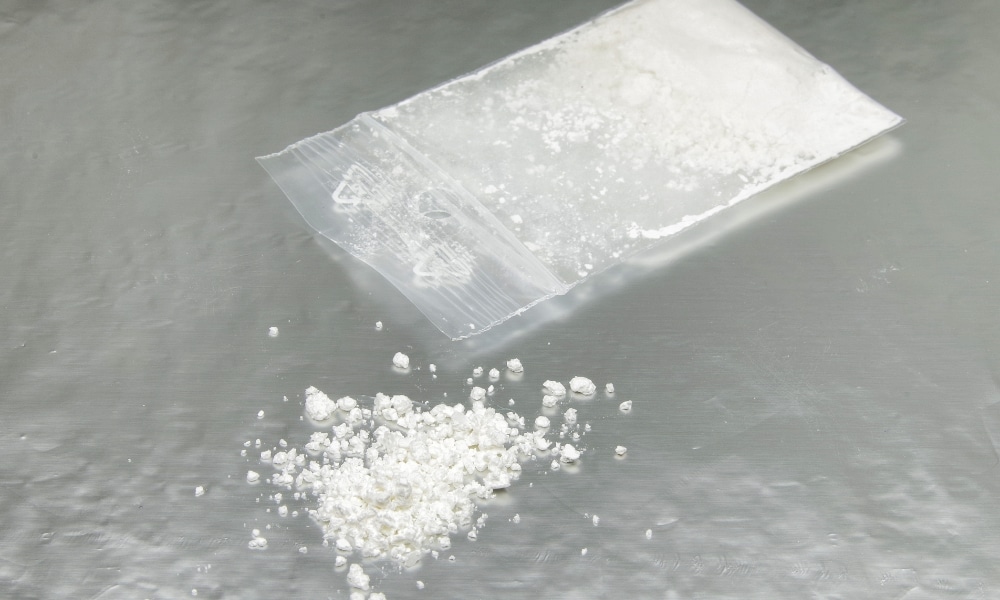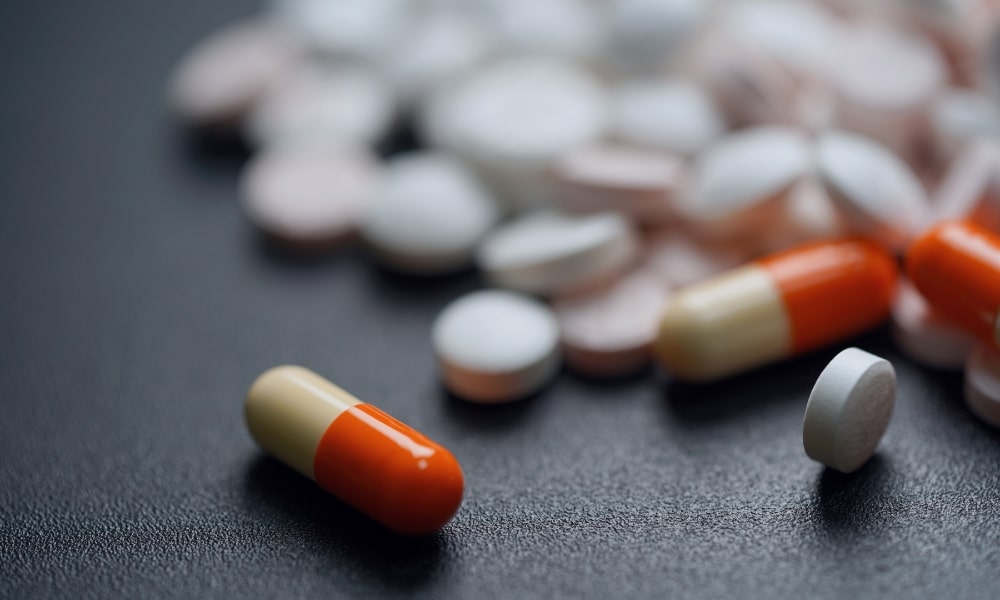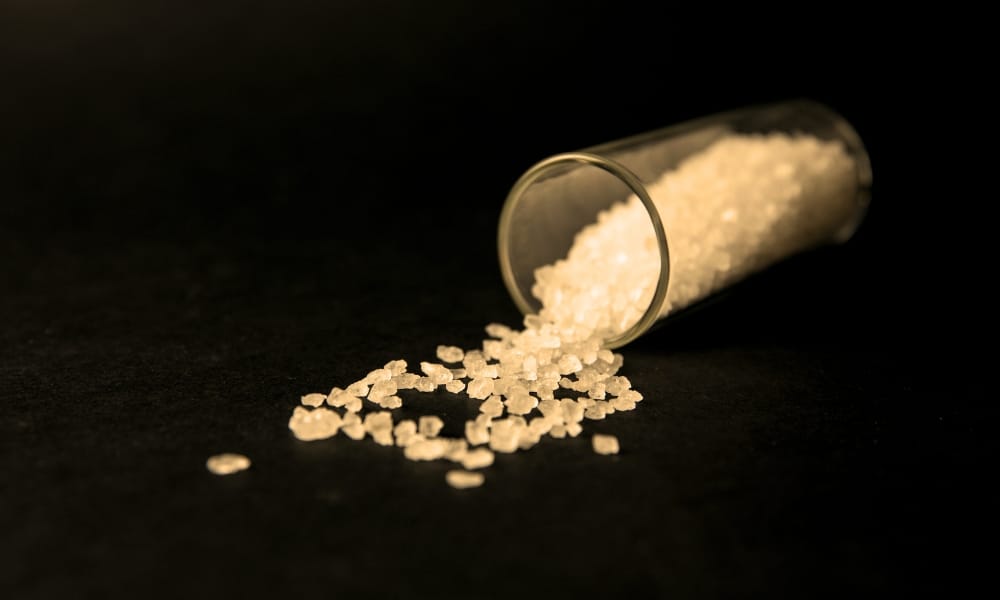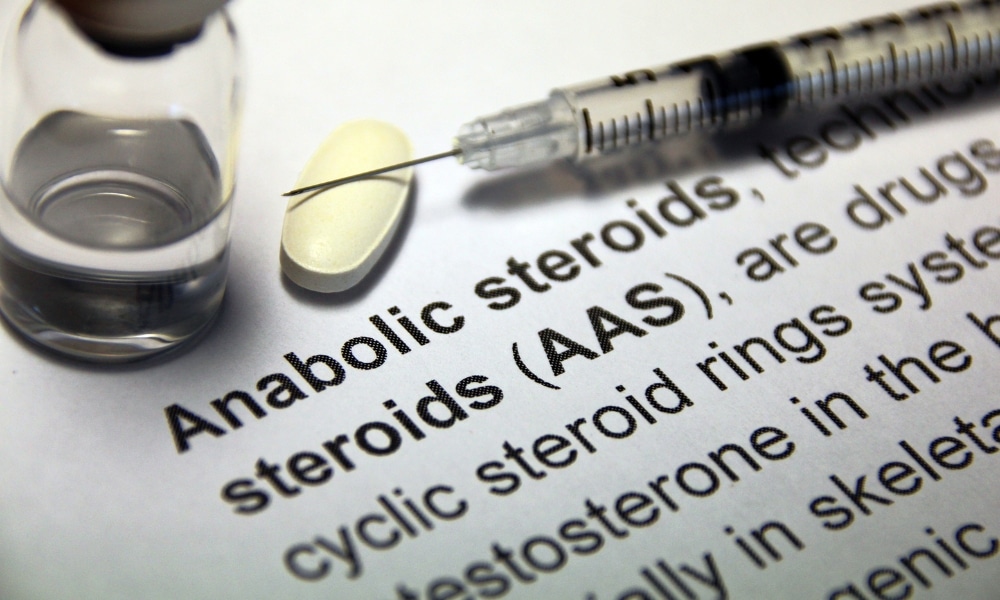Skip To Section
Stimulants are highly abused drugs, and some of the most notorious illegal drugs are in this category. Long-term abuse of stimulants can have significant consequences, including long-term health risks. There are a variety of examples of stimulant drugs you may or may not have heard of.
The following are examples of stimulant drugs:
- Cocaine
- Methamphetamine
- Prescription stimulants
- Synthetic cathinones (bath salts)
- Nicotine
- Ecstasy (MDMA)
- Diet pills
- Caffeine

Cocaine
One of the most well-known examples of illegal stimulant drugs, cocaine is derived from the South American coca plant. Although you may think of cocaine as an illicit drug, it’s still used rarely for medical purposes such as a topical anesthetic or in respiratory procedures.
Cocaine is classified as a Schedule II controlled substance by the U.S. Drug Enforcement Administration (DEA). This means that it can be used for limited medical purposes in specific circumstances. However, its medical uses are limited, and it’s not typically prescribed for individual use.
Cocaine abuse happens through several different modes of administration, including:
- Grinding it up into a powder and snorting it
- Smoking it (crack cocaine)
- Mixing it with water and injecting it
You can also take cocaine orally, the most infrequent method of administration.
Crack cocaine is made by heating up powdered cocaine and crystallizing it, which makes it suitable for smoking.
Cocaine Effects
Regardless of the way you use cocaine, the effects are similar.
Cocaine’s short-term effects may include:
- Euphoria
- A rush of energy
- Excitability and feelings of invincibility
- Dilated pupils
- Decreased appetite
- Less need for sleep
- Psychosis (hallucinations and/or delusions)
- Tremors or shakiness
- Erratic behaviors
- Irritability and agitation
The effects of a cocaine high are typically short-lived. When cocaine is snorted or smoked, the effects last for less time. Cocaine users typically binge on the drug. The effects of the drug rapidly dissipate, and feelings of apathy and depression begin to take over. This leads to constantly binging on the drug to avoid the crash.
As with most stimulants, tolerance to cocaine develops quickly. If you begin using cocaine on a regular basis, you will need to increase the amount you use significantly, within a very short period, to get the same effects.
Eventually, the euphoria associated with cocaine use (and other stimulants like methamphetamine) becomes less intense. You’ll need to continue abusing cocaine to avoid the negative effects of the crash and withdrawal, which may include:
- Lethargy
- Irritability
- Apathy
- Depression
Health Effects of Cocaine Use
People who snort cocaine may have runny or bloody noses. People who smoke crack may develop respiratory issues. Other physical and psychological issues are regularly associated with cocaine use.
Long-term effects of cocaine abuse may include:
- Cardiovascular issues like inflamed heart lining, heart attack, and aortic ruptures
- Brain bleeding
- Problems with movement
- Long-term damage of the nasal septum and loss of smell
- Gastrointestinal tract ulcerations
- Anxiety
- Depression
- Panic disorders
- Sexual dysfunction
Cocaine Abuse Rates
Rates of cocaine abuse peaked in the 1980s and 1990s, and then declined due to the popularity of other less expensive drugs. The Substance Abuse and Mental Health Services Administration (SAMHSA) reports that in 2020:
- 5.2 million Americans used cocaine at least once.
- 657,000 Americans used crack cocaine at least once.
- Americans ages 18-25 used the most cocaine.
- 1.3 million Americans aged 12 or older met the diagnostic criteria for a cocaine use disorder.

Methamphetamine
Like cocaine, methamphetamine (meth or crystal meth) is known widely as an example of stimulant drugs, but it’s also a Schedule ll controlled substance. Medicinal methamphetamine (brand name: Desoxyn) is prescribed to treat ADHD in cases that don’t respond to other stimulants. Methamphetamine may also be prescribed to treat extreme obesity.
Illegal methamphetamine is often manufactured in private laboratories. Street methamphetamine or crystal meth is produced by extracting stimulant medications from over-the-counter drugs, like cold medicines or diet aids, and combining them with other substances. Many of these other substances are potentially toxic such as paint thinner, anti-freeze, and battery acid. The combination produces a powder or crystal form of methamphetamine.
Crystal meth is usually smoked or injected. Regular meth abuse and the adulterants used in making meth can damage several parts of your body, including:
- Teeth (“meth mouth” or rotting teeth)
- Skin
- Heart
- Liver
- Lungs
- Brain
Meth Effects
The effects of meth and crystal meth are similar to the effects of cocaine, although in some cases, the euphoria and feelings of invulnerability may be more extreme. The effects of meth come on quickly and intensely. In addition to euphoria, meth users may feel uninhibited and more sexual. They may be very talkative and energetic.
Health Effects of Meth
Aside from the toxic effects, medical issues from methamphetamine abuse may include:
- Extremely elevated body temperature that can lead to dehydration and/or brain damage
- Seizures
- Psychosis symptoms
- Severe itching
- Long-term cognitive issues because of alterations and damage to the brain
- Cardiovascular problems
- Cancer
- HIV
- Stroke
- Depression
- Anxiety
Since meth is commonly smoked or injected, there’s a temptation to binge on it, increasing the risk of psychosis and seizures. When you are binging on a drug, overdose is more likely, and an overdose on meth can be fatal. In 2020, around 23,827 Americans died by a drug overdose on meth or other psychostimulants.
Meth Abuse Rates
Crystal meth abuse may have contributed to the decrease of cocaine abuse in the U.S. Meth is less expensive and easier to obtain than cocaine. However, abuse of meth has declined somewhat in recent years due to the popularity of prescription medications for pain.
According to SAMHSA, in 2020:
- Of the 10.3 million Americans who abused CNS stimulants, 1.5 million met the criteria for a methamphetamine use disorder.
- Meth use was highest among Americans ages 18 to 25.

Prescription Stimulants
Some prescription stimulants are potential drugs of abuse, most notably drugs used to treat ADHD and diet aids like Dexedrine. Like other examples of stimulant drugs, prescription stimulants work by increasing the amounts of neurotransmitters in the brain like dopamine and norepinephrine. This can lead to:
- Increased focus
- Improved energy
- Decreased appetite
- Lowered need for sleep
Drugs that contain the stimulant methylphenidate (Ritalin and Concerta) and medications that contain amphetamines (Adderall and Dexedrine) are examples of prescription stimulants.
These drugs are not often abused by people who have legitimate prescriptions for them. People with prescription drug abuse issues generally get pills from those with legitimate prescriptions or buy them on the street. When abused, the pills are typically crushed, and the powder is snorted. Some substance abusers mix stimulant pills with water and inject it.
Prescription stimulants can produce similar effects as cocaine and methamphetamine when abused. You may also experience similar adverse consequences as with cocaine and meth abuse.
Health Effects of Prescription Stimulants
People may not think of prescription stimulants as “serious drugs” like cocaine and meth, but the long-term effects of abusing drugs like Adderall are significant.
Regular stimulant abuse can lead to outcomes like:
- Rapid breathing
- Increased blood pressure, breathing, blood sugar, and irregular heart rate
- Higher blood pressure
- High body temperature
- Heart failure
- Nausea
- Vomiting
- Seizures
- Paranoia
- Diarrhea
- Coma
- Anger
- Psychosis
- Hepatitis and HIV (if injected)
Overdose symptoms of prescription stimulants may include:
- Confusion
- Restlessness
- Tremors
- Fever
- Muscle pain
- Hallucinations
- Panic
- Quick breathing
Prescription Stimulant Abuse Rates
Prescription stimulant abuse is popular among college students, often used to cram for exams and write research papers. People who are in high-pressure jobs may also abuse prescription stimulant drugs to improve focus and work longer. However, prescription stimulant abuse is not associated with increased academic achievement or job performance when they are not used for a diagnosable medical condition. Over the long run, stimulant abuse is more likely to cause deficiencies in these areas.
According to SAMHSA, in 2020:
- 5.1 million Americans misused prescription stimulant medications.
- 353,000 Americans misused prescription stimulants, cocaine, and methamphetamine.
- Americans ages 18-25 abused prescription stimulants more than any other age group.

Synthetic Cathinones (bath salts)
Synthetic cathinones are “designer drugs,” which means they are made with legal substances to mimic the effect of other examples of stimulant drugs. Also known as bath salts, makers of these drugs skirt the law by constantly switching out ingredients that become illegal or controlled. Synthetic cathinones come in packages similar to bath salts for bathing that say, “Not for human consumption.”
The U.S. Drug Enforcement Administration (DEA) classifies some of the ingredients in bath salts as Schedule I drugs with no known medical use and a high potential for abuse. What makes drugs like bath salts tricky for lawmakers is that the composition keeps getting tweaked as ingredients are banned. The new ingredient is often more dangerous. It’s a long and complex process to get a substance controlled or banned, so lawmakers have a hard time staying on top of the evolving drug. To this end, the United Nations Office on Drugs and Crime gave bath salts the designation of “New Psychoactive Substances (NPS),” which means it challenges drug policy and poses a high risk to public health.
Effects of Bath Salts
Bath salts can provide short-term effects like feeling less inhibited, more sexual, and having more energy. Long-term effects of these stimulants can be concerning, and may include:
- Dehydration
- Organ damage
- Heart attack
- Nerve and neurotransmitter damage
- Memory loss
- Problems with learning, speaking, and understanding
- Poor concentration
- Agitation and violent behaviors
- Panic attacks
- Anxiety
Bath Salts Abuse Rates
According to SAMHSA, in 2020:
- 118,000 Americans over age 12 used synthetic stimulants.
- 118,000 Americans aged 12 to 17 used synthetic stimulants.
- In all other age groups, 75,000 people or less used synthetic stimulants.
"*" indicates required fields
Fill out the form below and one of our admissions team members will reach out to you:
"*" indicates required fields
Other Common Substances With Stimulant Properties
Drugs that contain stimulants or that have similar chemical properties as stimulants are also commonly abused. Some of these include:
- Steroids
- Caffeine
- Ecstasy
These medications can be prescribed for certain medical conditions, but they are often misused and abused for their stimulant effects.

Steroids
Abuse of anabolic steroids, synthetic forms of testosterone, most often occurs in athletes and bodybuilders. While these drugs have stimulant properties, they are not common drugs of abuse except for in this subset of individuals, but they can be addictive.
Long-term abuse of steroids can lead to significant medical issues, including:
- Increased risk of cancer.
- Developing male secondary sexual characteristics in females.
- Developing female secondary sexual characteristics in males.
- Increased aggression and emotional functioning that can include outbursts of anger and problems managing emotions.

Caffeine
Of all the drugs in the world used for their psychoactive effects, caffeine is the most widely used. Caffeine is found in:
- Tea
- Coffee
- Chocolate
- Energy drinks
- Over-the-counter weight loss medications
- Most soft drinks
While it’s normally not dangerous, consuming too much caffeine can lead to issues with insomnia and anxiety. Caffeine can trigger other long-term health effects, such as an increased risk for cardiovascular disease.
Caffeine can produce physical dependence (withdrawal symptoms). Withdrawal from caffeine can be distressing, and can include:
- Lethargy
- Fatigue
- Irritability
- Headaches

Ecstasy
Ecstasy, also known as Molly, is the street name for the drug 3, 4-methylenedioxy-methamphetamine (MDMA). The drug has both stimulant and hallucinogenic effects and is known as a “club drug.” In addition to producing stimulation and hallucinations, Molly can also make you feel more social.
The drug affects many different neurotransmitters. Long-term use is linked to significant alterations in the central nervous system.
MDMA is being investigated for its potential to treat post-traumatic stress disorder (PTSD). Currently, it is a Schedule l controlled substance. This means it is illegal to possess it except with special permission from the government (such as for research).
Ecstasy sold on the street today is often cut with other substances, including methamphetamine and other drugs. In 2020, 7.1 million Americans used hallucinogens like Ecstasy. Use was greatest among Americans aged 18-25.
How Do You Treat Stimulant Addiction?
Continuing to abuse stimulants can lead to a stimulant use disorder, the clinical term to describe abuse or addiction to stimulants.
Although withdrawal from stimulant medications is typically not fatal, you can experience significant emotional distress and physical issues that require medical attention.
An addiction treatment program for stimulant use disorders should include the following components:
- A thorough assessment of physical, cognitive, emotional, and social functioning to develop a treatment plan.
- Placement in a physician-assisted medical detox program to assist with stimulant withdrawal symptoms.
- Medications to address withdrawal symptoms and other issues.
- Behavioral interventions, such as addiction therapy, process and experiential groups, and 12-step groups to learn coping skills and prevent relapse.
- Treatment for any co-occurring mental health issues.
- A long-term aftercare program to prevent relapse.
If you are concerned with your stimulant use or that of a loved one, call Vogue Recovery Center. We provide research-based treatment in welcoming, home-like environments among staff who truly care about your recovery and peers who understand what you’re going through. Call us today.
- Signs of Substance Abuse
- Self-Assessment Questionnaire
- Underlying Causes of Addiction
- Is Addiction a Disease or a Choice?
- Physical vs Psychological Addiction
- The DEA Drug Schedule
- What is the Cost of Addiction
- Slang & Street Terms for Drugs
- GHB Abuse Recovery
- How Do Drugs Affect the Heart?
- What Are Prescription Stimulants?
- What Are Stimulant Withdrawal Symptoms?
- Drug Scheduling – DEA
- Key Substance Use and Mental Health Indicators in the United States: Results from the 2020 National Survey on Drug Use and Health
- Cocaine | National Institute on Drug Abuse (NIDA)
- Methamphetamine: MedlinePlus
- Prescription drug abuse – Symptoms and causes – Mayo Clinic
- Anabolic Steroids and Other Appearance and Performance Enhancing Drugs (APEDs)
- Summary of Misuse of Prescription Drugs | National Institute on Drug Abuse (NIDA)
- What Are Bath Salts? – Kids Health
- Psychoactive Bath Salts and Neurotoxicity Risk – PMC
- Harmful effects of nicotine – PMC
- Summary of Misuse of Prescription Drugs | National Institute on Drug Abuse (NIDA)
- ADHD drugs do not improve cognition in healthy college students | ScienceDaily
Our admissions team is available 24/7 to listen to your story and help you get started with the next steps.


